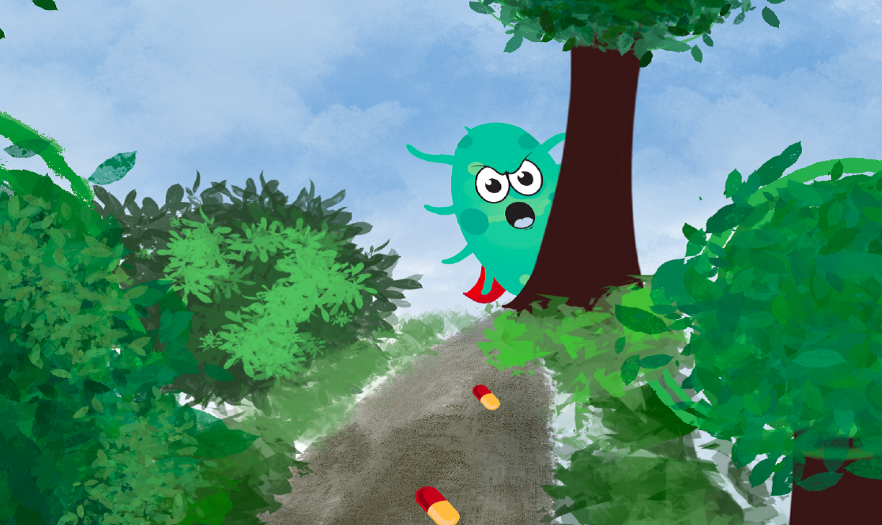Where the Wild Things Are: Missing the Forest for the Trees
Lynn Lieberman Lawry, Senior Gender Advisor, and Niranjan Konduri, Deputy Technical Director, USAID MTaPS
 During the pandemic, overburdened health care systems deprioritized antimicrobial stewardship programs by diverting resources, personnel, and attention from the diagnosis and management of antimicrobial resistance (AMR) to COVID-19 diagnosis, tracing, and infection prevention and control (IPC). The pandemic illustrated the importance of IPC, hygiene, and vaccine uptake. The pandemic also revealed antibiotic misuse that contributed to elevating the risk of AMR. Further, between 2019 and 2021, routine immunizations dropped to their lowest rates in 30 years, leaving the possibility that vaccine preventable diseases will become more prevalent and will be inappropriately treated with antibiotics.
During the pandemic, overburdened health care systems deprioritized antimicrobial stewardship programs by diverting resources, personnel, and attention from the diagnosis and management of antimicrobial resistance (AMR) to COVID-19 diagnosis, tracing, and infection prevention and control (IPC). The pandemic illustrated the importance of IPC, hygiene, and vaccine uptake. The pandemic also revealed antibiotic misuse that contributed to elevating the risk of AMR. Further, between 2019 and 2021, routine immunizations dropped to their lowest rates in 30 years, leaving the possibility that vaccine preventable diseases will become more prevalent and will be inappropriately treated with antibiotics.
The pandemic left positive legacies that normalized mask usage and handwashing, which will help us prevent the transmission of many different infectious diseases—a key strategy for containing AMR. Now we need to expand our focus to include AMR multisectoral coordination in line with the One Health approach and we must align efforts with all the strategic objectives of containing AMR, with recognition of sex and gender–related impacts on AMR.
We must not lose the forest for the trees and miss addressing the bigger lurking danger of unchecked AMR—a reminder that took center stage at the Global Health Security (GHS) Conference in Singapore in July 2022.
Call for One Health and Equity at the Global Health Security Conference 2022
Although donors, programs, and country authorities alike focused on improving IPC during the pandemic among communities and at health facilities, discussions abounded at the GHS conference on the need to focus on the broader aspects of an AMS program.
Although IPC is important, what have we sacrificed for our focus on IPC? The poignant question was raised by a participant at the GHS Conference. The need of the hour to improve our efforts on a One Health approach to improve AMS programs was a consistent theme in discussions throughout the conference. One Health is an approach that recognizes that the health of people is intertwined with the health and well-being of animals and our shared environment.
Although each of the AMR strategic objectives is vital, the thought leaders at the conference agreed that the COVID-19 pandemic and climate change point to One Health as being of paramount importance, as we may see more zoonotic outbreaks that start with a jump of an infectious disease from animals to humans. The recent declaration of monkeypox being a “Public Health Emergency of International Concern”, a Langya virus outbreak in China, and a Tomato flu outbreak in India are case in point that makes One Health argument even more compelling. As rivers dry up in Europe and glaciers melt, we are left with new risks and exposures to bacteria and viruses not seen for tens of thousands of years. Our rapidly changing environment urges us to recognize the need for a global One Health approach to fighting antimicrobial resistance.
The Singapore Statement at the GHS Conference states, “We must embrace the fact we live together on one planet, deeply connected to each other and our natural environment” and “[prevent] future unintended disease events [through] surveillance of animal and environmental conditions, including in urban settings, and the adoption of policies and standards that proscribe activities that harm the natural environment.”
Global health security depends on embracing a One Health approach.
How can we practice a One Health approach for global health security? Cooperation and equity consideration must underpin these efforts. The Statement affirmed that global health security “can only be achieved and maintained through concerted, cooperative action at all levels—from local communities to the international system—when acting in solidarity, informed by equity.”
For an equitable approach, addressing differences in AMR risk by sex, gender, and minorities will be key in shaping interventions—a criteria that USAID Medicines, Technologies and Pharmaceutical Services (MTaPS) program has begun to incorporate in its activities as part of its support to implement national action plans to contain AMR in counties.
What is USAID MTaPS Doing
In support of the Global Health Security Agenda (GHSA) Action Package on AMR, MTaPS is working in 13 countries to strengthen multisectoral coordination rooted in the One Health approach, IPC, antimicrobial stewardship, and health care waste management. Through collaboration with national, district, and health facility–level counterparts, the program implements IPC and AMS programs that involve performance assessments for continuous quality improvement, health worker training, and mentorship.
Only with a comprehensive approach of AMS, IPC, and multisectoral coordination that also factors in sex and gender–based differences and the inequities thereof can we succeed in reducing the spread of AMR.